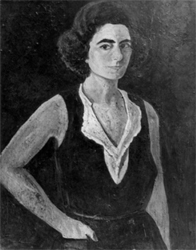Tina Morpurgo
Tina Morpurgo | |
|---|---|
 Self-portrait of Tina Morpurgo | |
| Born | 6 March 1907 |
| Died | 1 June 1944 (aged 37) |
| Cause of death | Murdered in Holocaust |
| Nationality | Croat |
| Occupation | Painter |
| Relatives | Vid Morpurgo (great uncle) |
Tina Morpurgo (March 6, 1907 – June 1, 1944) was a notable Croatian painter from Split.[1][2]
Morpurgo was born on March 6, 1907 in Split to the notable Jewish Morpurgo family which originated from Marburg, Germany.[3][4] After high school she devoted herself to painting and in 1931 she held her first single exhibition which showed over fifty of her works in oil, tempera and drawing. In 1932, Morpurgo attended a private school in Trieste. Morpurgo planned to pursue her schooling and further artistic development in Munich, but due to the rise of Nazism and the economic crisis, she remained in her hometown, and, disillusioned, stopped painting. In 1943 she was deported to the Banjica concentration camp together with her parents. On June 1, 1944, Morpurgo was killed by Schutzstaffel members. Despite this well-known fact, during the time of communist Yugoslavia she was falsely put on the list of the Jasenovac concentration camp victims as a part of communist anti-Croatian propaganda.[5] Her paintings were saved by the surviving members of her family and friends. Later her paintings were exhibited, in 1974, at the Jewish community of Split, at the Jewish community Belgrade, and the Jewish Historical Museum in Belgrade in 1975.[1][6][7][8]
References
- ^ a b Duško Kečkemet (1971)
- ^ Rogošić, Željko (2007-12-20). "Slavne žene Dalmacije" (in Croatian). Nacional. Retrieved 2013-01-25.
{{cite news}}: Cite has empty unknown parameter:|coauthors=(help) - ^ Tonkin, Boyd (2010-08-20). "Boyd Tonkin: The magnificent Morpurgos". The Independent. Retrieved 2013-08-16.
{{cite news}}: Cite has empty unknown parameter:|coauthors=(help) - ^ Kuzmanić, Nepo. "Obitelj Morpurgo, Židovi iz Marburga". Slobodna Dalmacija. Retrieved 2013-08-16.
{{cite news}}: Cite has empty unknown parameter:|coauthors=(help) - ^ "Jasenovačka pljačka novaca Ministarstva kulture" (in Croatian). Retrieved 2016-04-24.
- ^ Gospodnetić, Lenka (3 April 2010). "Mirjana Kučer: Splićanke stenju pod muškim jarmom" (in Croatian). Slobodna Dalmacija. Retrieved 2013-01-25.
{{cite news}}: Cite has empty unknown parameter:|coauthors=(help) - ^ Wright, Lola (1 February 2012). "Velike Splićanke koje je povijest zaboravila" (in Croatian). Slobodna Dalmacija. Retrieved 2013-01-25.
{{cite news}}: Cite has empty unknown parameter:|coauthors=(help) - ^ Pavičić, Jurica (10 January 2008). "Ženska povijest Splita" (in Croatian). Jutarnji list. Retrieved 2013-01-25.
{{cite news}}: Cite has empty unknown parameter:|coauthors=(help)
Bibliography
- 1907 births
- 1944 deaths
- People from Split, Croatia
- Croatian Jews
- Austro-Hungarian Jews
- Painters who died in Nazi concentration camps
- Croatian Austro-Hungarians
- Croatian people of German-Jewish descent
- Croatian painters
- Jewish painters
- People who died in Banjica concentration camp
- Croatian civilians killed in World War II
- Croatian people executed in Nazi concentration camps
- Croatian women artists
- 20th-century women artists
